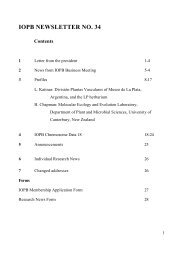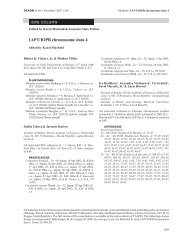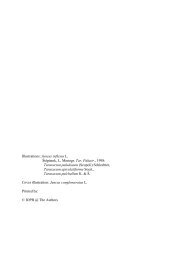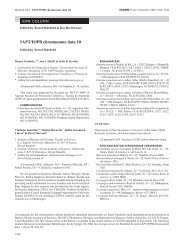CONTENS - International Organization of Plant Biosystematists
CONTENS - International Organization of Plant Biosystematists
CONTENS - International Organization of Plant Biosystematists
You also want an ePaper? Increase the reach of your titles
YUMPU automatically turns print PDFs into web optimized ePapers that Google loves.
O 47<br />
Geographic parthenogenesis and phylogeography in Hieracium<br />
alpinum L. (Asteraceae)<br />
Patrik Mráz 1,2 , Philippe Choler 1 , Jindřich Chrtek 3 , Delphine Rioux 1 & Pierre Taberlet 1<br />
1 Université Joseph Fourier, Laboratoire d'Ecologie Alpine, UMR UJF-CNRS 5553,<br />
PO Box 53, F-38041 Grenoble Cedex 9, France; patrik.mraz@unifr.ch<br />
2 University <strong>of</strong> Fribourg, Unit <strong>of</strong> Ecology and Evolution, CH-1700 Fribourg, Switzerland<br />
3 Institute <strong>of</strong> Botany, Academy <strong>of</strong> Sciences <strong>of</strong> the Czech Republic, CZ-25243<br />
Průhonice, Czech Republic<br />
Hieracium alpinum s.str. is an arcto-alpine species spreading from the far North<br />
(Greenland, Iceland, Scotland, Scandinavia, Northern Russia) to the southerlysituated<br />
European mountain system (Alps, Carpathians, Sudetes, Vosges, Vranica<br />
planina). While sexually reproducing diploids occur solely in the Eastern and<br />
Southern Carpathians, apomictic triploids cover the rest <strong>of</strong> the range. We used AFLP<br />
markers and ITS sequencing for inferring <strong>of</strong> genetic structure and origin <strong>of</strong><br />
geographical parthenogenesis in this species. AFLP data suggest polytopic origin <strong>of</strong><br />
triploid apomicts with almost no genetic relatedness to the recent diploids. Although<br />
triploid populations show usually very low genetic variation, several populations from<br />
Central Europe are very variable because they include genetically very distant<br />
clones. Past migration among different triploid populations and independent<br />
recolonization might explain the extant <strong>of</strong> genetic variation <strong>of</strong> some triploid<br />
populations in Central Europe. Northern populations consist virtually from only one or<br />
several closely related AFLP genotypes, suggesting very strong genetic bottleneck<br />
during postglacial recolonization <strong>of</strong> northern Europe. Genetic data, non-overlapping<br />
range <strong>of</strong> diploids and triploids, and occurrence <strong>of</strong> many closely-related microspecies<br />
within triploid range indicate that triploid plants <strong>of</strong> H. alpinum are likely not<br />
descendants <strong>of</strong> recent diploid populations, but rather they are remnants <strong>of</strong> extinct<br />
diploid lineages.<br />
48










